Abstract
The state of health (SOH) of a lithium-ion battery (LIB) should be accurately estimated to ensure its safe operation under various driving conditions for electric vehicles. To estimate the SOH of LIBs, it is necessary to develop a technique that can properly process data with nonlinear characteristics related to the voltage and temperature of various electrochemical reactions in the batteries. To this end, we adopted wavelet transform methods to facilitate feature extraction for the preprocessing of nonlinear characteristic data from LIBs. Convolutional neural network (CNN) and long short-term memory (LSTM) techniques were used for the lithium-ion SOH estimation using the wavelet transform method. SOH estimation models using either the conventional data preprocessing technology normalization or wavelet transform method were compared. The SOH estimation accuracy of the model in which the wavelet transform was applied to the LSTM learning technology was 98.92%, and it was confirmed that the performance was improved compared with that of the normalization technology. In summary, this paper proposes a method that can improve the SOH estimation accuracy of LIBs compared to conventional methods by using data with nonlinear characteristics related to intrinsic changes in the voltage and temperature of LIBs.
1. Introduction
As the number of vehicles powered by fossil-fuel-burning internal combustion engines has increased, carbon dioxide emissions have also increased, and the climate change problem has emerged as a global topic. To overcome this problem, studies on electric vehicles (EVs) to replace internal combustion engine vehicles have been gaining momentum [1]. Lithium-ion batteries (LIBs) are used as an energy source in EVs because of their advantages, which include a high energy density, long life, and high efficiency [2]. A LIB may overheat as a result of over-charging and over-discharging depending on various driving conditions for the EV, causing fires and explosions [3,4]. In other words, the state of a LIB has a significant effect on the safety of an EV, which implies that real-time estimation of the battery state is imperative [5]. Real-time estimation of the battery state refers to estimations of its state of health (SOH) and state of charge. Among these, its SOH is an important indicator of battery life and is defined as a percentage of the capacity of the fully charged battery at the current point in time relative to the initial capacity [6]. As a battery’s deterioration progresses, its lifespan decreases, reducing its safety [7]. Therefore, its SOH is an indicator that is directly related to the safety of the battery, and it is crucial to estimate it accurately [8,9,10]. The performance of a LIB deteriorates as a result of a variety of conditions, such as repeated charging and discharging, its internal temperature, and charging and discharging current [11,12]. Therefore, it is difficult to clearly formulate a method for determining the performance degradation of a battery. It is necessary to develop an algorithm that can accurately estimate the SOH [13].
Methods for estimating the SOH of a battery include model- and data-based estimation methods. Model-based estimation methods use an electrochemical battery equivalent circuit model and adaptive filters to estimate the SOH [14]. The adaptive filters used include the Kalman filter (KF) and particle filter (PF). The KF uses a recursive method to compare the previous estimate and the current measured value to reduce errors, thereby increasing the estimation accuracy [15]. However, a regular KF is used in linear models and is not suitable for battery models that include nonlinearity. Therefore, Sepasi et al. [16] estimated the SOH by linearizing a nonlinear system with an extended Kalman filter (EKF). However, the EKF produces an estimation error because the state variable is estimated by linearizing the nonlinear system through a Jacobean matrix [14]. Chen et al. [17] used an unscented Kalman filter (UKF) to estimate the SOH. The UKF facilitates more accurate SOH estimation because the state variable is estimated relatively error-free by using approximates without obtaining the Jacobian matrix for linearization, unlike the EKF. In the case of the aforementioned EKF and UKF, the noise must satisfy a Gaussian distribution. In contrast, the PF method is suitable for estimating the state of a LIB, which is a nonlinear and non-Gaussian system because of various electrochemical reactions [18]. The PF finds random particle samples with weights that are related to the post-probability density. When this process is repeated, the weight tends to become 0 [19]. To solve this problem, Datong et al. [20] estimated the SOH by providing a distribution closer to the actual post-distribution through an unscented particle filter (UPF) that combined the UKF and PF algorithms. However, there were limitations in solving physical and chemical changes and various noises in the LIB model [21].
Meanwhile, data-based methods estimate the SOH by using a machine learning approach without requiring the analysis of electrochemical reactions [22]. Recently, many studies have been conducted using data-based methods. Nuhic et al. [23] analyzed data to find patterns and estimated the SOH using the support vector machine, which is an algorithm for approximating nonlinearities. Datong et al. [24] used the relevance vector machine to improve the accuracy and reliability of a battery’s SOH estimation. Li et al. [25] estimated the SOH based on ensemble learning by extracting six deterioration features from battery data. Furthermore, Ren et al. [26] proposed an algorithm to estimate the SOH by combining a deep neural network and an autoencoder. You et al. [27] estimated the SOH based on recurrent neural networks (RNNs) using the voltage and current data over time. In RNNs, the memory used to remember the sequences in long inputs becomes shorter, which may cause the vanishing and exploding gradient problem. In previous studies, general data preprocessing techniques (e.g., Normalization) and mathematical battery models that are generally applied to data preprocessing were used. These limit the SOH accuracy of LIB with nonlinearity. To preprocess the data with such nonlinearities, Maher et al. [28] estimated the SOH by applying continuous wavelet transform (CWT) to the voltage profile of the battery. Jun Xu et al. [29] estimated SOH by applying discrete wavelet transform (DWT). The CWT facilitates the extraction of useful features related to battery deterioration by converting one-dimensional (time) battery data into two-dimensional (time-frequency domain) data. The DWT facilitates the extraction of electrochemical features from signals with a broad frequency range through multi-resolution analysis.
In this study, we proposed a preprocessing method suitable for SOH estimation using both CWT and DWT. In the case of CWT, it was possible to increase the estimation accuracy. In the case of DWT, since a neural network was not used in existing papers, a SOH estimation method was proposed using LSTM. To confirm the usefulness of the proposed algorithm, the SOH estimation technique by normalization and SOH estimation results were compared. From this, it was found that the SOH estimation accuracy using the wavelet technology proposed in this study was high. It was confirmed that the proposed algorithm is more suitable for data with nonlinearity than the conventional preprocessing method. Furthermore, regarding the impacts of the specific wavelet-related methods, we found that it was more appropriate to apply the DWT methods to the LSTM than to the CNN and CWT.
The remainder of this paper is organized as follows. Section 2 describes the data composition. Section 3 describes CWT and DWT, which are preprocessing methods, the CNN and LSTM methods, which are machine learning methods, were explained, as well as the neural network model structure for SOH estimation. Section 4 compares the SOH estimation performances of the LSTM and CNN models to verify the accuracy of the proposed model, the SOH estimation performance of the proposed method was examined, and its validity was determined.
2. Data Composition
An actual EV battery operates in various driving environments. Therefore, to obtain battery data similar to the actual EV driving environment, this study utilized a randomized battery usage dataset measured at the NASA Ames Prognostics Center of Excellence [30]. The extension of the data is .mat, and the size of the entire data is about 1 GB. Table 1 shows the characteristics of the LIB. Here, the random walk profile consists of a random current in the range −4.5 to 4.5 A. A random current (−4.5, −3.75, −3, −2.25, −1.5, −0.75, 0.75, 1.5, 2.25, 3.0, 3.75, and 4.5 A) is used for charging and discharging. A negative or positive current indicates charging or discharging, respectively. A random current was applied for 5 min to end one cycle, and a break of 1 s was repeated. For safe operation, the maximum and minimum threshold voltages were 4.2 and 3.2 V, respectively. Additionally, if the voltage is exceeding the threshold, the 1 step is finished within 5 min. The random walk continues for 1500 steps. After RW, the reference charge and reference discharge are performed twice. Figure 1 shows the whole process of data cycles. The discharge reference is used to obtain the capacity. Therefore, this paper uses reference discharge for SOH estimation.

Table 1.
Specifications of lithium–ion batteries.

Figure 1.
The whole process of data cycles.
Figure 2 shows the measurements of the first 50 RW steps and the last 50 RW steps of the RW9 cell. The actual measurement time of 50 RW steps should be about 4.2 h, but they are 3.5 h and 1 h, respectively. This is because when the minimum and maximum threshold voltages are reached, the current step ends and the next step begins. In the last 50 steps, the time is significantly reduced because the minimum mill maximum threshold voltage is often reached. The reason the threshold voltage is often reached is that the internal resistance increases.
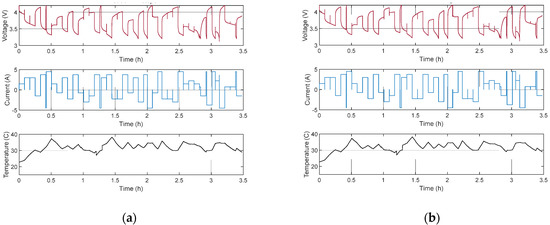
Figure 2.
The RW steps measured for battery RW9: (a) first 50 RW steps; (b) last 50 RW steps.
As the number of charging and discharging cycles for a LIB increase, the battery’s capacity decreases, and the internal resistance increases. Figure 3 is the reference discharge profile. It can be seen that as the discharge cycle increases, the discharge time becomes shorter, and the temperature increases. Through this, it can be seen that as the charge and discharge cycles increase, the internal resistance increases, which affects the capacity degradation. Therefore, in this paper, voltage and temperature data were used by utilizing the discharge curves of a total of four cells of lithium-ion batteries RW9, RW10, RW11, and RW12. Voltage data and temperature data were used to extract feature points through wavelet transformation and train the neural network model.
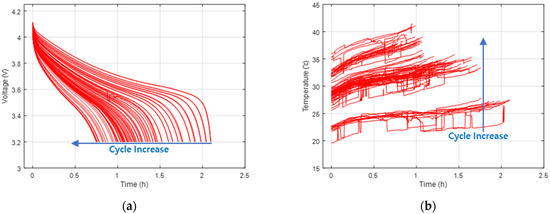
Figure 3.
The reference discharge profile of RW9: (a) voltage; (b) temperature.
3. SOH Estimation Methods
3.1. Preprocessing Methods
3.1.1. Continuous Wavelet Transform (CWT)
Unlike the Fourier transform, which has a fixed resolution and cannot represent the characteristics of non-periodic signals well, wavelet transform methods have the advantage that signals can be analyzed efficiently using a wavelet function that has flexible resolution [31]. A time-series analysis using the wavelet transform utilizes , the mother wavelet, which is defined in Equation (1).
Equation (1) moves the wavelet function by on the time axis and adjusts the scale by s to decompose the signal. Given the mother wavelet, the CWT of signal is defined in Equation (2).
The wavelet coefficients obtained from Equation (2) shows the similarity between f(t) and . The wavelet transform decomposes the time domain of to produce signals only, however, the time–frequency domain can be obtained by pseudo-frequencies. is the inner product of the wavelet function. The wavelet function comprises a set of functions with different cycles. Based on this characteristic, it has the advantage that multi-resolution decomposition is possible. The relationship between the scale and pseudo-frequencies varies depending on the center of the wavelet function, scale performance, and sampling cycle. The spectrum of the wavelet function is maximized at a given scale. Equation (3) shows the relationship between these parameters.
In Equation (3), denotes the center frequency, denotes the sampling cycle, and denotes the result of the pseudo-frequency. All signals were synthesized by applying the inverse CWT defined by Equation (4) as follows:
is an acceptance constant that can be obtained when the mother wavelet satisfies all the requirements. The results of CWT are shown in Figure 4.
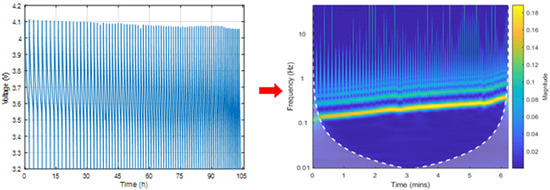
Figure 4.
Result of CWT of reference discharge-RW09.
3.1.2. Discrete Wavelet Transform (DWT)
In CWT, s and have positive real values, and in this case, the computational processes increase because the resulting values of the wavelet transform for the signals are highly redundant. To reduce the computational process, dynamic sampling was performed, as defined in Equation (5).
The DWT with the changed parameters is defined as follows:
Through this process, the original CWT becomes a discrete wavelet function and a scaling function.
When analyzing signals using the DWT, the wavelet coefficient of the signal can be obtained as follows:
Evidently, the signals are decomposed into approximations and details using Equations (10) and (11). The discrete wavelet and scaling functions act as low- and high-frequency filters, respectively. The results of DWT are shown in Figure 5.
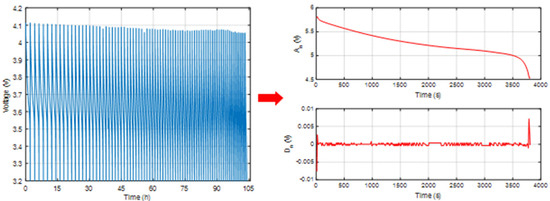
Figure 5.
Result of DWT of reference discharge -RW09.
3.2. Deep Learning Methods
3.2.1. Convolutional Neural Network (CNN)
The CNN was inspired by the principle of recognizing objects in the brain’s visual cortex [32]. A CNN often consists of convolutional, pooling, and fully connected layers. The main function of the convolutional layer is to obtain a feature map through the convolutional operation of the filter for the input. A convolutional layer often consists of a learnable kernel and bias. The kernel size corresponds to the filter size, and the kernel’s depth corresponds to the number of channels in the feature map. The convolutional layer’s input can be obtained through the inner product of the weight and cognitive domains and can be expressed by Equation (12).
In Equation (12), represents the convolutional value of the -th channel in convolutional layer , represents the -th output of pooling layer , represents the kernel of convolutional layer , represents the bias of the -th channel in convolutional layer , and ∗ represents the convolutional operation.
After the convolutional operation is completed, the value of the convolutional layer is calculated based on the activation function. The rectified linear unit (ReLU), which is an activation function, is commonly used for pattern recognition and shows excellent performance in accelerating the convergence and solving vanishing gradient problems. Therefore, the ReLU activation function is commonly used as an activation function for the convolutional layer, and the output of the convolutional layer can be expressed by Equation (13).
Here, represents the output of the -th channel in convolutional layer , and represents the activation function.
After the convolutional layer operation, the pooling layer is often used to extract additional features. The pooling layer reduces the dimensions of the output of the previous layer. Therefore, the essential function of the pooling layer is to reduce the computation of the computer by reducing the volume of data. The pooling layer types include the max, average, logarithmic, and weight pooling layers. Among these, max pooling has the general advantage of speeding up convergence and improving generalization. The max pooling function is expressed as Equation (14).
Here, represents the filter of the pooling layer, which can move to a specific step corresponds to the pooling layer dimensions, represents the output of the -th channel in the convolutional layer, and represents the overlap between the pooling layer and the channel output.
In general, a CNN model includes multiple convolutional and pooling layers, which sequentially extract the feature points. The extracted feature points are converted into vectors and used as inputs to the fully connected layer. The main function of the fully connected layer is to extract additional features and connect them to the SoftMax classifier in the case of classification models and regression in the case of regression models. Fully connected layers often consist of two or three hidden layers, and all neurons of a hidden layer can be expressed by Equation (15).
Here, represents the weight matrix of the fully connected layer, represents the bias, and represents the fully connected function’s activation function.
3.2.2. Long Short-Term Memory (LSTM)
An RNN can collect the latest information. However, because the memory for long sequences of inputs is shortened, the vanishing and exploding gradient problem can occur. LSTM cells were used to overcome this drawback. LSTM was proposed to address the vanishing and exploding gradient problem [33]. The memory of an LSTM cell has the characteristics of being stored and converted from an input to an output in the cell state. As shown in Figure 6, the LSTM comprises the forget, output, input, and update gates. The forget gate decides what to forget from the previous memory unit, the input gate decides to accept the input, and the output gate generates a new long-term memory. These four main components of LSTM interact with each other by accepting long-term memory, short-term memory, and input sequence values and generating new long-term and short-term memory at a given specific step. The input gate decides which information is to be sent to the cell. Equation (16) is the mathematical equation for the input gate.
In Equation (16), the operator ∗ represents the multiplication of each element of the vector, represents activation function, represents the weight, represents the hidden state of a previous point and represents the bias. The information to be ignored in the previous memory is defined by a mathematical equation for the forget gate, as expressed by Equation (17).
The cell state is updated by the update gate, which is defined by mathematical equations, as expressed in Equations (18) and (19).
The hidden layer of the previous step is updated by the output gate, which updates the output as follows.
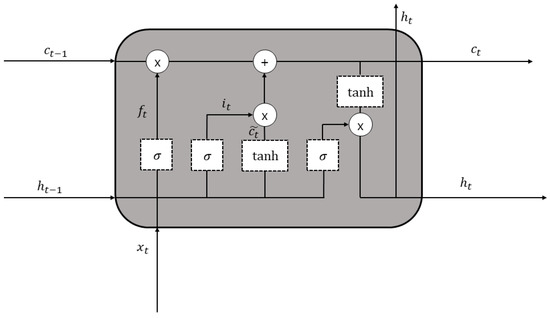
Figure 6.
Structure of LSTM.
3.2.3. Construction of a Neural Network Model
Figure 7 shows the SOH estimation process for the LIB using its discharge signals. The voltage and temperature data of the battery are preprocessed using wavelet transform and features are extracted. The extracted data is used as an input for training a neural network model for estimating the SOH. In this case, the CWT transforms the 1-D signal of the battery into 2-D image data using the Bump Wavelet function.
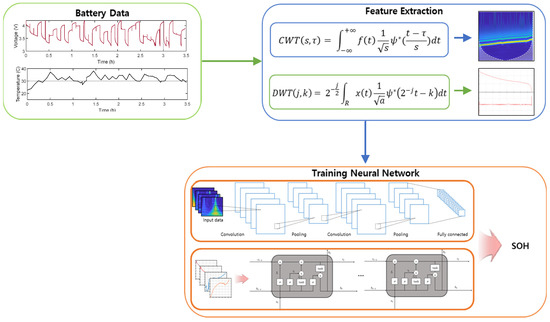
Figure 7.
The SOH estimation process using wavelet transform and neural network.
Additionally, the DWT applies the Daubechies Wavelet 10 and extracts the Approximation level 1 signal. After that, data using CWT is put into the CNN model as an input, and data using DWT is put into the LSTM as an input to estimate the SOH.
The first layer of the constructed CNN for estimating the SOH of the LIB had eight 3 × 3 kernels, the second layer had 16 3 × 3 kernels, and the third and fourth layers had 16 kernels each. Furthermore, additional features were extracted through the fully connected layer, and the SOH information of the LIB was estimated through the regression layer. After completing the convolutional operations in each layer, we applied max pooling, which is a type of pooling layer for batch normalization and computational speed improvement, to overcome the vanishing and exploding gradient problem. Then, we applied the drop-out to prevent the overfitting of the model [34]. The model construction of CNN is shown in Table 2.

Table 2.
Construction of the CNN model for SOH estimation.
The LSTM neural network for estimating the SOH of the LIB consisted of a total of 125 cells. The state activation function of the LSTM neural network cells was constructed using a hyperbolic tangent, and the gate activation function was constructed using a sigmoid function. Furthermore, additional features were extracted through the fully connected layer, and the SOH information of the LIB was estimated through the regression layer. The model construction of LSTM is shown in Table 3.

Table 3.
Construction of the LSTM neural network model for SOH estimation.
4. Simulation
Figure 8 shows the structure of the simulation system. The MATLAB/Simulink Wavelet Toolbox was used to extract features using wavelet transforms, and the MATLAB/Simulink Deep Learning Toolbox was used to implement the LSTM model. The simulation system was implemented by constructing the proposed SOH estimation model for a LIB. The experimental setting is a desktop with CPU Intel i7 10700K, GPU NVIDIA GeForce GTX 1660 S 6 GB, and RAM 16 GB.
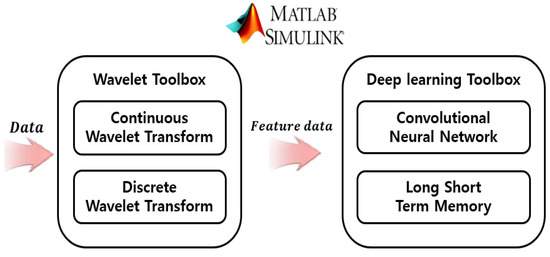
Figure 8.
Schematic diagram of the simulation system.
4.1. Learning Using Data
Using the composed LIB dataset, we trained the CNN and LSTM neural networks. When training each neural network, we optimized the neural network using Adam Optimizer and used the regression function as an activation function to estimate the LIB’s SOH. Furthermore, to examine the learning performance of the neural network models, we used 80% of the LIB in each cell dataset as the training dataset and 20% as the test dataset to determine each model’s performance.
4.2. Comparison of Model Performances Using the Battery Dataset
To compare the LIB SOH estimation performances of the LSTM neural network model using the DWT, as expressed in Table 4, the estimation accuracy was determined for each data point using the Equation below. Figure 9 shows the actual SOH values and SOH estimation graphs obtained using the neural network models.

Table 4.
Comparison of battery SOH estimation performance.
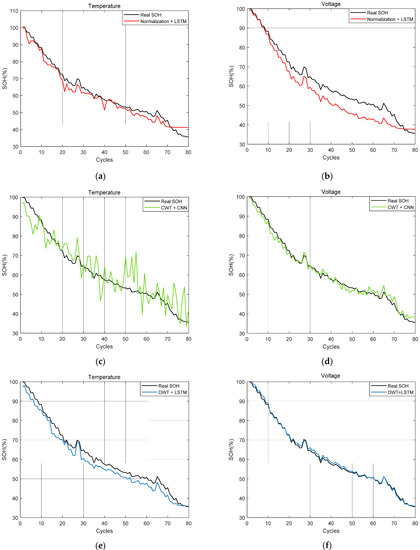
Figure 9.
SOH estimation results: (a,b) are normalization + LSTM, (c,d) are CWT + CNN and (e,f) are DWT + LSTM.
In Equations (22)–(25), n denotes the number of test data points. Here, RMSE represents the robustness of the estimation, MAE accuracy refers to the estimation accuracy of SOH, and MAX is the maximum error value. The SOH estimation accuracy using Normalization and LSTM for the voltage and temperature were 94.85% and 93.49%, respectively. The SOH estimation accuracy using CWT and CNN for the voltage and temperature were 96.82% and 94.68%, respectively. The SOH estimation accuracy using DWT and LSTM for the voltage and temperature were 98.92% and 96.45%, respectively. All three models exhibited excellent performance when using the voltage data.
All three models exhibited excellent performance when using the voltage data. This is due to the time-dependent nature of the voltage and temperature data associated with the charging and discharging of lithium-ion batteries. In lithium-ion batteries, the internal resistance increases as the number of repetitions of charging and discharging increases. The continuity of the voltage curve that occurs at this time is superior to that of the temperature curve as shown in Figure 3. In particular, as the charge and discharge time elapses, the temperature curve becomes irregular and the continuity decreases. The learning algorithm applied in this study was able to solve the nonlinearity of the data to some extent. However, it was confirmed that the SOH estimation accuracy was relatively low because the temperature characteristic curve was very discontinuous. Instead, we found that the SOH accuracy was excellent for the same algorithm because the voltage curve had better continuity than the temperature curve. When comparing the performance of the model using wavelet and Normalization, it can be seen that the accuracy of the wavelet is high. This confirms that the proposed algorithm is advantageous for nonlinear battery data learning.
The performance was verified by comparing the relative errors of the three models. A boxplot was then used to compare the performances of the three models to evaluate the variance of the relative error. The mathematical equation of the relative error is the same as in Equation (26).
Here, are the estimated and actual SOH values, respectively. The boxplot mainly focused on the maximum, minimum, median, third quartile, and first quartile. In Table 5, IQR is the difference between the third quartile and the first quartile. The relative errors of different SOHs are compared in Figure 10 and the data are described in Table 6.

Table 5.
Relative error of different methods.

Figure 10.
Relative error boxplot for each SOH estimation.

Table 6.
Relative error of different methods.
The estimation accuracies of the SOH were compared in the case of using temperature data. When comparing the LSTM with normalization, the variance of the relative error of the LSTM was narrow and maximum value small. In addition, it was confirmed that there were no outliers in the relative error for the LSTM; however, outliers occurred when using normalization. Although the estimation accuracy of the CNN, comparing CNN and normalization, was high, the variance of the error was wide and the maximum value relatively large. Outliers existed in both models. When comparing the LSTM and CNN, it was confirmed that the variance of the relative error of the LSTM was narrow and maximum value smaller. The LSTM did not have outliers, but CNN had outliers.
For the voltage data case, the estimation accuracies of the SOH were compared. When comparing the LSTM with normalization, the variance of the relative error of the LSTM was narrow and the maximum value small. In both models, there were no outliers in the relative error. When the CNN and normalization are compared, the variance of the relative error of CNN was narrow and the maximum value small. However, there was an outlier for CNN, but not for normalization. Finally, when comparing LSTM and CNN, it can be seen that the variance and maximum value of the relative error of the LSTM were small, and there were no outliers.
One reason for this difference between the two models was possibly the difference in learning. The CNN model did not consider the historical values based on time because it learned the entire image information, which was not related to a specific time. In contrast, the LSTM model was trained while considering the historical values based on time. Therefore, in terms of the SOH estimation accuracy of the LIB, the LSTM training method was more appropriate and fully reflects changes in the characteristic values (voltage and temperature) of the lithium ions caused by charging and discharging over time.
5. Conclusions
In this study, to improve the SOH estimation accuracy of a LIB, we introduced wavelet (CWT and DWT)-based preprocessing methods, which overcame the limitations of conventional studies when processing nonlinear characteristic data, and proposed a learning optimization method based on these. To confirm the usefulness of the proposed algorithm, we compared the SOH estimation results of the LIB using the wavelet technique and Normalization, which are existing data preprocessing techniques.
When the temperature data were used, which is a variable related to the SOH estimation of a LIB, the SOH accuracy was 93.49% for the technique using normalization and LSTM, 94.38% for the technique using CWT and CNN, and 96.45% for the technique using DWT and LSTM. When the relative errors were compared, the relative error variance of the DWT and LSTM was relatively narrow and the maximum value relatively low. Therefore, the accuracy was excellent when the wavelet was used compared to the existing data preprocessing technique (normalization). When CNN and LSTM were compared, the estimation accuracy of the LSTM was excellent.
When voltage data were used, the SOH accuracy was 94.85% for the using normalization and LSTM, 97.71% for using CWT and CNN, and 98.92% for the using DWT and LSTM method. When the relative errors were compared, the relative error variances of DWT and LSTM were the narrowest and minimum values low, similar to the temperature data. Therefore, as with the temperature data, it was found that the accuracy was excellent and the estimation accuracy of the LSTM was excellent when the wavelet was used compared with the conventional pretreatment.
By combing all of the aforementioned results, the SOH estimation accuracy using voltage data was greater than that when temperature data were used, and the SOH estimation accuracy was higher when DWT and LSTM were used. This confirmed the usefulness of the algorithm proposed in this study and it was demonstrated that the voltage is the most important factor of the LIB SOH accuracy estimation related variables. Therefore, it was confirmed that our proposed wavelet-based data processing and LSTM training methods, which showed excellent characteristics reflecting the time-series data, were useful in improving the SOH estimation accuracy.
In the future, we aim to establish a method for further improving the SOH estimation accuracy by adding the effects of data for characteristics other than the voltage and temperature of a LIB that was the focus of this study.
Author Contributions
Conceptualization, J.-k.L.; formal analysis, J.-k.L.; methodology, M.-S.P. and J.-k.L.; project administration, B.-W.K.; software, J.-k.L.; supervision, B.-W.K.; validation, M.-S.P.; visualization, M.-S.P.; writing—original draft, M.-S.P.; writing—review & editing, B.-W.K. All authors have read and agreed to the published version of the manuscript.
Funding
This work was supported by the Industrial Strategic Technology Development Program (20010132, “Development of the systematization technology of e-powertrain core parts development platform for expending the industry of xEV parts”) and the Korea Institute for Advancement of Technology (KIAT) (P0018434, “Building an open platform ecosystem for future technology innovation in the automotive industry”) funded by the Ministry of Trade, Industry & Energy (MOITE, Korea).
Conflicts of Interest
The authors declare no conflict of interest.
References
- Cano, Z.P.; Banham, D.; Ye, S.; Hintennach, A.; Lu, J.; Fowler, M.; Chen, Z. Batteries and fuel cells for emerging electric vehicle markets. Nat. Energy 2018, 3, 279–289. [Google Scholar] [CrossRef]
- Nishi, Y. Lithium ion secondary batteries; Past 10 years and the future. J. Power Sources 2001, 100, 101–106. [Google Scholar] [CrossRef]
- Abada, S.; Marlair, G.; Lecocq, A.; Petit, M.; Sauvant-Moynot, V.; Huet, F. Safety focused modeling of lithium-ion batteries: A review. J. Power Sources 2016, 306, 178–192. [Google Scholar] [CrossRef]
- Sun, J.; Li, J.; Zhou, T.; Yang, K.; Wei, S.; Tang, N.; Dang, N.; Li, H.; Qiu, X.; Chen, L. Toxicity, a serious concern of thermal runaway from commercial Li-ion battery. Nano Energy 2016, 27, 313–319. [Google Scholar] [CrossRef]
- Wang, Y.; Zhang, C.; Chen, Z. An adaptive remaining energy prediction approach for lithium-ion batteries in electric vehicles. J. Power Sources 2016, 305, 80–88. [Google Scholar] [CrossRef]
- Wang, Y.; Zhang, C.; Chen, Z. A method for joint estimation of state-of-charge and available energy of LiFePO4 batteries. Appl. Energy 2014, 135, 81–87. [Google Scholar] [CrossRef]
- Feng, X.; Lu, L.; Ouyang, M.; Li, J.; He, X. A 3D thermal runaway propagation model for a large format lithium ion battery module. Energy 2016, 115, 194–208. [Google Scholar] [CrossRef]
- Waag, W.; Fleischer, C.; Sauer, D.U. Critical review of the methods for monitoring of lithium-ion batteries in electric and hybrid vehicles. J. Power Sources 2014, 258, 321–339. [Google Scholar] [CrossRef]
- Berecibar, M.; Garmendia, M.; Gandiaga, I.; Crego, J.; Villarreal, I. State of health estimation algorithm of LiFePO4 battery packs based on differential voltage curves for battery management system application. Energy 2016, 103, 784–796. [Google Scholar] [CrossRef]
- Dai, H.; Zhao, G.; Lin, M.; Wu, J.; Zheng, G. A novel estimation method for the state of health of lithium-ion battery using prior knowledge-based neural network and markov chain. IEEE Trans. Ind. Electron. 2019, 66, 7706–7716. [Google Scholar] [CrossRef]
- Stroe, D.I.; Swierczynski, M.; Stan, A.I.; Teodorescu, R.; Andreasen, S.J. Accelerated lifetime testing methodology for lifetime estimation of lithium-ion batteries used in augmented wind power plants. IEEE Trans. Ind. Appl. 2014, 50, 4006–4017. [Google Scholar] [CrossRef]
- Khumprom, P.; Yodo, N. A data-driven predictive prognostic model for lithium-ion batteries based on a deep learning algorithm. Energies 2019, 12, 660. [Google Scholar] [CrossRef] [Green Version]
- Kang, S.H.; Noh, T.W.; Lee, B.K. Machine Learning-based SOH Estimation Algorithm Using a Linear Regression Analysis. Trans. Korean Inst. Power Electron. 2021, 26, 241–248. [Google Scholar]
- Plett, G.L. Extended Kalman filtering for battery management systems of LiPB-based HEV battery packs—Part 1. Background. J. Power Sources 2004, 134, 252–261. [Google Scholar] [CrossRef]
- Kim, Y.; Bang, H. Introduction to Kalman Filter and Its Applications. Introd. Implement. Kalman Filter 2019, 1, 1–16. [Google Scholar] [CrossRef] [Green Version]
- Sepasi, S.; Ghorbani, R.; Liaw, B.Y. Inline state of health estimation of lithium-ion batteries using state of charge calculation. J. Power Sources 2015, 299, 246–254. [Google Scholar] [CrossRef]
- Chen, Z.P.; Wang, Q.T. The Application of UKF Algorithm for 18650-type Lithium Battery SOH Estimation. Appl. Mech. Mater. 2014, 519–520, 1079–1084. [Google Scholar] [CrossRef]
- Liang, J.; Peng, X.-Y. Improved particle filter for nonlinear system state. Electron. Lett. 2008, 44, 1275–1277. [Google Scholar] [CrossRef]
- Miao, Q.; Xie, L.; Cui, H.; Liang, W.; Pecht, M. Remaining useful life prediction of lithium-ion battery with unscented particle filter technique. Microelectron. Reliab. 2013, 53, 805–810. [Google Scholar] [CrossRef]
- Liu, D.; Yin, X.; Song, Y.; Liu, W.; Peng, Y. An on-line state of health estimation of lithium-ion battery using unscented particle filter. IEEE Access 2018, 6, 40990–41001. [Google Scholar] [CrossRef]
- Qu, J.; Liu, F.; Ma, Y.; Fan, J. A Neural-Network-Based Method for RUL Prediction and SOH Monitoring of Lithium-Ion Battery. IEEE Access 2019, 7, 87178–87191. [Google Scholar] [CrossRef]
- Oji, T.; Zhou, Y.; Ci, S.; Kang, F.; Chen, X.; Liu, X. Data-Driven Methods for Battery SOH Estimation: Survey and a Critical Analysis. IEEE Access 2021, 9, 126903–126916. [Google Scholar] [CrossRef]
- Nuhic, A.; Terzimehic, T.; Soczka-Guth, T.; Buchholz, M.; Dietmayer, K. Health diagnosis and remaining useful life prognostics of lithium-ion batteries using data-driven methods. J. Power Sources 2013, 239, 680–688. [Google Scholar] [CrossRef]
- Liu, D.; Zhou, J.; Liao, H.; Peng, Y.; Peng, X. A health indicator extraction and optimization framework for lithium-ion battery degradation modeling and prognostics. IEEE Trans. Syst. Man Cybern. Syst. 2015, 45, 915–928. [Google Scholar] [CrossRef]
- Li, Y.; Zhong, S.; Zhong, Q.; Shi, K. Lithium-ion battery state of health monitoring based on ensemble learning. IEEE Access 2019, 7, 8754–8762. [Google Scholar] [CrossRef]
- Ren, L.; Zhao, L.; Hong, S.; Zhao, S.; Wang, H.; Zhang, L. Remaining Useful Life Prediction for Lithium-Ion Battery: A Deep Learning Approach. IEEE Access 2018, 6, 50587–50598. [Google Scholar] [CrossRef]
- You, G.W.; Park, S.; Oh, D. Diagnosis of Electric Vehicle Batteries Using Recurrent Neural Networks. IEEE Trans. Ind. Electron. 2017, 64, 4885–4893. [Google Scholar] [CrossRef]
- El-Dalahmeh, M.; Al-Greer, M.; El-Dalahmeh, M.; Short, M. Time-frequency image analysis and transfer learning for capacity prediction of lithium-ion batteries. Energies 2020, 13, 5447. [Google Scholar] [CrossRef]
- Xu, J.; Mei, X.; Wang, X.; Fu, Y.; Zhao, Y.; Wang, J. A Relative State of Health Estimation Method Based on Wavelet Analysis for Lithium-Ion Battery Cell Cells. IEEE Trans. Ind. Electron. 2021, 68, 6973–6981. [Google Scholar] [CrossRef]
- Bole, B.; Kulkarni, C.; Daigle, M. Randomized battery usage data set. In NASA AMES Prognostics Data Repository; NASA Ames Research Center: Moffett Field, CA, USA, 2014. [Google Scholar]
- Gamero, L.G.; Vila, J.; Palacios, F. Wavelet transform analysis of heart rate variability during mycardial ischaemia. Med. Biol. Eng. Comput. 2002, 40, 72–78. [Google Scholar] [CrossRef]
- Li, X.; Zhang, W.; Ding, Q. Deep learning-based remaining useful life estimation of bearings using multi-scale feature extraction. Reliab. Eng. Syst. Saf. 2019, 182, 208–218. [Google Scholar] [CrossRef]
- Hochreiter, S.; Schmidhuber, J. Long short-term memory. Neural Comput. 1997, 9, 1735–1780. [Google Scholar] [CrossRef] [PubMed]
- Srivastava, N.; Hinton, G.; Krizhevsky, A.; Sutskever, I.; Salakhutdinov, R. Dropout: A simple way to prevent neural networks from overfitting. J. Mach. Learn. Res. 2014, 15, 1929–1958. [Google Scholar]
Publisher’s Note: MDPI stays neutral with regard to jurisdictional claims in published maps and institutional affiliations. |
© 2022 by the authors. Licensee MDPI, Basel, Switzerland. This article is an open access article distributed under the terms and conditions of the Creative Commons Attribution (CC BY) license (https://creativecommons.org/licenses/by/4.0/).